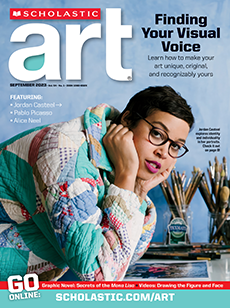Romanticism in literature was equally varied, developing many new forms. The emphasis on imagination and emotion led to the flourishing of lyric poetry. These are short poems that express personal emotion. The Gothic novel, with its emphasis on mystery and the supernatural, and the historical novel were popular prose forms. Least interest was shown in drama. Many plays were written to be read rather than performed. The exception was in France, where the battle for romanticism was fought in the theater, the home of an established neoclassical tradition.
In England all the major romantic poets wrote lyric poetry, each in an individual voice. William Wordsworth and Samuel Taylor Coleridge published a collection of poems called Lyrical Ballads (1798). John Keats is famous for his odes, including "To Autumn" and "Ode to a Nightingale" (both written in 1819), as is Percy Bysshe Shelley. George Gordon, Lord Byron, wrote longer narrative poems, such as Childe Harold's Pilgrimage(1812). Of the poetry of William Blake, Songs of Innocence (1787) and Songs of Experience (1797) are the most widely read.
In Germany, romantic literature ranged widely from the difficult theories of Friedrich von Schlegel and his brother August Wilhelm to the fantastic tales of Johann Ludwig Tieck and E. T. A. Hoffmann. The outstanding lyric poets were Novalis (Friedrich von Hardenberg) and, later, Heinrich Heine.
The greatest romantic poet in France was Victor Hugo. His vast output also included novels, such as Les Misérables (1862), and plays. Alfred de Musset wrote both plays and poems. Alphonse de Lamartine is known for his touching nature poetry. Alexandre Dumas was the author of many lively tales, among them The Three Musketeers (1844). Italy's foremost romantic poet was the melancholy Giacomo Leopardi. Spain's was José de Espronceda.
Romanticism came somewhat later in the United States than in Europe. But it was a vigorous movement there with distinctive themes. The love of nature took a philosophical form in the group of New England writers known as transcendentalists. Their views are expressed in Nature (1836), by Ralph Waldo Emerson, and Walden (1854), by Henry David Thoreau. The theme of the American frontier experience was introduced by James Fenimore Cooper in such well-loved tales as The Last of the Mohicans (1826) and The Deerslayer (1841). This tradition was continued by Henry Wadsworth Longfellow in The Song of Hiawatha (1855). The poems of Walt Whitman were published after 1855 under the title Leaves of Grass. They celebrate the American spirit and remain influential.
American romanticism is particularly rich in prose narratives that have become an important part of the country's literature. These include the novels Moby-Dick (1851), by Herman Melville, and The Scarlet Letter (1850), by Nathaniel Hawthorne, and the short stories of Edgar Allan Poe.
